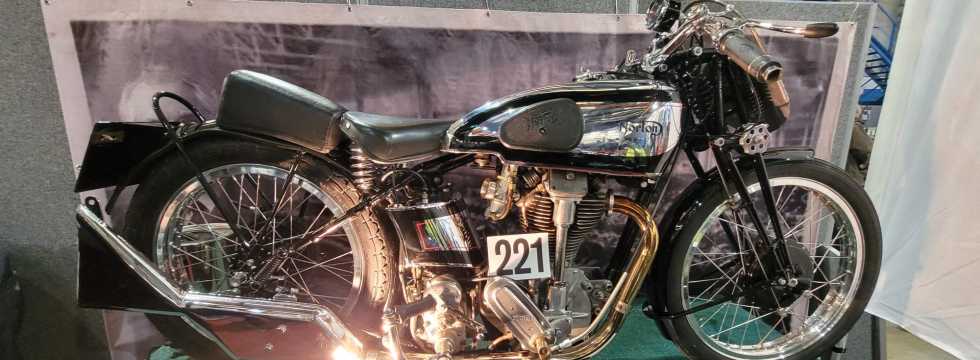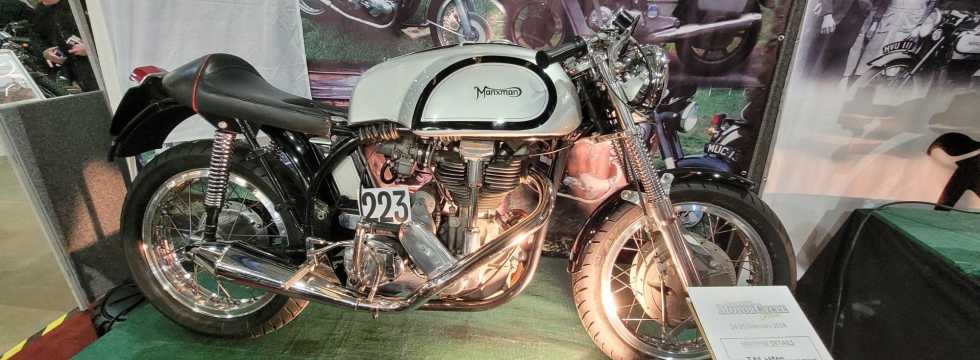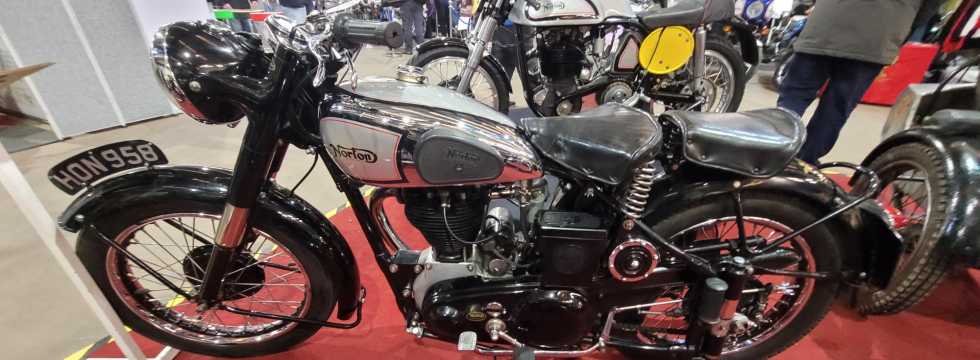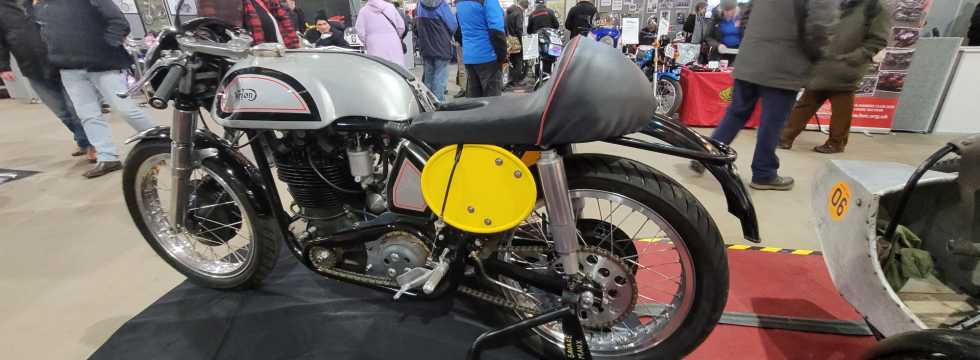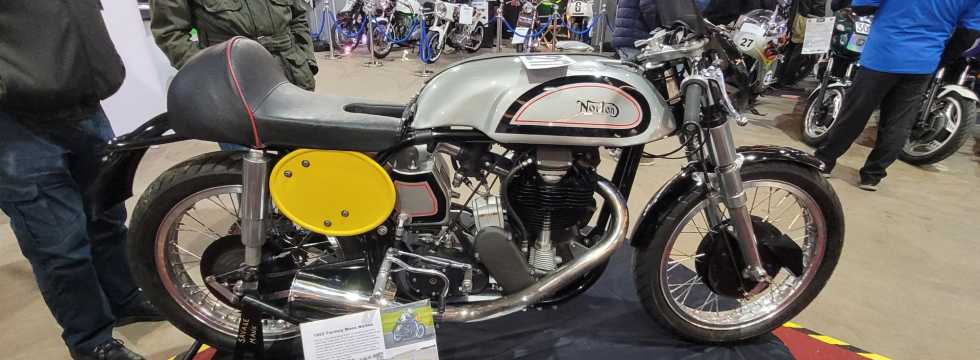A review of correspondence from NOC-L
A discussion on steering head bearings and the use of tapered roller types
Taper roller vs. ball types
The Commando headstock bearing is a standard sealed ball race type 6205-2RS, which measures 25 x 52 x 15mm. The taper roller equivalent is the type 30205. The Japanese seem to make proprietary equivalents of some of these bearings with seals, for motorcycle use. I have not found a source for the sealed roller bearings, aside from perusing the parts bins at my local motorcycle shop. Note that though the 30205 is 1.25mm 'thicker' than the ball race, there is no practical difference, since the threaded steering column allows for adjustment. Also, when using the ball bearings, a spacer is required between the inner races to avoid pre-loading. This spacer must either be eliminated when using the taper rollers, or shimmed accurately to give the correct end float.
Greg Kricorissian (grkricor@ccs.carleton.ca) on NOC-L 25th. Nov 1997
Taper roller head bearings - making them fit
With the taper roller bearing, it has been said by some that you can't use the original headlamp brackets of the Atlas/G15/early Commando. With Gregg's information, the assertion makes sense, as the distance between steering crown and handlebar lug will be 2.5mm wider than standard (provided roller bearings are fitted to both ends of the stem). But making a shouldered spacer of 2.5mm thickness to fit at top of the headlamp brackets (similar to what Matchless did on the Teledraulics) should remedy a difference in length. Add 1mm and even the spigot rubber spacer could be replaced.
Knut Soensteby (knut.sonsteby@lhg.hib.no) on NOC-L 26th. Nov 1997
Fitting taper roller head bearings
The earlier Norton steering stems suit the adaption to taper rollers much better, because of the fine threads make it easier to adjust the bearing clearance. Also with the early design, since the top nut locks the bearing adjustment nut under the top yoke without altering the clearance, it is inherently a better system to use with taper rollers. The nut on the later system was designed to clamp up rigidly, and its coarse threads are not well suited to adjusting the bearing clearance. With the later stem, you must use a spacer as I describe below.
If you have the earlier style Commando (or Atlas, or Dommi) stem, don't worry about this ... just fit the rollers, and proceed with adjusting the clearance with the nut beneath the upper yoke, and lock it with the top nut. With the later system, you must use a spacer between the inner races, so that you end up with the correct bearing clearance when the lower nut is tightened fully. How you arrange this spacer is a matter for personal ingenuity, but in the past I've made up a tubular steel spacer that is a little too short (i.e. causes the bearings to bind), and then gotten the proper fit by means of adding thin shims between the end of the spacer and an abutment that bears against the top bearing's inner race. You can get as fancy as you like here, but the idea is like the shimming system used in the Norton Isolastic mountings.
Do your initial fitting on the bench, and remember to pack the bearings with grease. However, before you make any final adjustments, ensure the outer races are fully seated in the frame headstock .. no matter how tightly you press them in, they will always 'seat' for the first several hours of use, and become loose. Thus, get the adjustment close, and then go for a ride. While making the final adjustments, keep in mind that the objective is to ensure the rollers can roll and not skid, nor hammer from looseness when loaded under rotational force. That is the main reason for light pre-loading, and this is quite OK with a taper roller, while it is very bad practice with a purely radial bearing such as a ball type. The other reason for pre-loading taper roller bearings (as in Velocette main bearings) is to ensure roller contact even when surrounding alloy (such as the crankcases) expands. With headstock bearings, expansion from heat is not an issue, and the adjustment is much less critical. As long as you take up the clearance so there is no bearing 'shake' when under load, things will be fine.
As things bed down, clearances will open up, and you should be very careful to remove shims to regain a proper fit. Check the fit by rolling the bike forward, and applying the front brake quickly. The feel should be free of shake, but there should be no binding at all in the steering. One last comment: - whereas most Japanese designs used angular contact bearings in the old days, virtually every one of their designs in recent years has a headstock fitted with taper rollers.
Greg Kricorissian (grkricor@ccs.carleton.ca) on NOC-L 26th. Nov 1997
Taper roller conversions - a question
I've seen articles on how to convert to tapered roller bearings that suggest discarding the spacer and getting a second lower nut (perhaps thinning both nuts for clearance) so you can lock the lower nut without tightening it fully. Would this method also work, or are there problems? I haven't tried either method, but it sounds as though taking the head apart to reshim it at intervals would be a real pain in the butt.
Mike Taglieri (miketync@aol.com) on NOC-L 28th. Nov 1997
Taper roller conversions - an answer
I put tapered roller bearings on my two Atlas's with no problems. I agree with the point, but I did not need to make a spacer. Nothing came loose.
Peter Sprot (sales@millergraphics.com) on NOC-L 27th. Nov 1997
Taper roller conversions - another answer
Correct [about the Atlas]. I should have pointed out that the Atlas yokes are perfectly suited as-is to using the taper roller bearings, since they have the correct bearing adjusting/locking mechanism in the steering stem. The problem (causing a need for a spacer) is really limited to the system used in the later Commandos.
Greg Kricorissian (grkricor@ccs.carleton.ca) on NOC-L 28th. Nov 1997
Taper roller conversions - more about making them fit
Upon inspecting the 1971 Commando forks (per 'explosion' drawing) I note they used 3 O-rings on each cover tube / headlamp bracket to resist rattling. But these rings will not fit the Atlas/G15/early Commando cover tubes in the lower area, just the upper region, due to the tapered cover design. I would say spacers are still worth considering for two reasons. While cup/cone bearings do not adjust much axially, tapered roller bearings do, and the increased thickness of the bearing itself adds to that. Secondly, if covers don't seal well, the stanchions will corrode badly. There is an easy way to circumvent the spacer problem. A bonded rubber spacer could easily be made by adding a 2.5mm plain rubber spacer to spacer T597 already in place. It will offer the advantage of increased compressibility which you need with the tapered bearings.
Knut Soensteby (knut.sonsteby@lhg.hib.no) on NOC-L 30th. Nov 1997
Taper roller conversions - more about making them fit
The steering stem does not protrude enough to fit two nuts on the end of the steering stem (i.e. using one as a jam nut). However, I suppose using a jam nut to maintain the adjustment could work, though the spacer technique is much more substantial, since the entire assembly is held in compression. I think the weakness of the jam nut method is that the steering stem would be free to fret in the lower yoke. I agree that dismantling at intervals to re-shim can be a real pain, whether it is your front end, or your valve clearances (as on many DOHC engines). That's why I've most often used other than Norton triple clamps (yokes), which can be more easily adjusted or dismantled.
Ones made by Ceriani, Betor, Marzocchi, etc are all very nice, and can be made to work well on the Norton frame (you may then wish to consider using their fork legs as well). Another system which is really nice, but not all that easy to find are the triple clamps from the Yamaha XT 550; a very light alloy assembly, easily and quickly adjustable with the threaded stem nuts, and very rigid: it has a total of 8 bolts to clamp the fork tubes to the yokes.
Greg Kricorissian (grkricor@ccs.carleton.ca) on NOC-L 30th. Nov 1997
Taper roller conversions - more about making them fit
So far no one has suggested fitting a different spindle. This could be done at a reasonable expense. By using a cryogenic process the head lug could be salvaged, there would be no thermal distortion and you would maintain the thermal fit. The stem could be made as long as you wish and with threads as desired. I would be happy to help anyone who wants to go this route.
On the other hand, there is a solution to the shimming problem. If a spring of sufficient stiffness is inserted along with a slightly shortened distance tube, the head stem could be tightened the normal way even with tapered roller bearings and thus maintaining compression on the yokes. Suggested material for the 'spring' is a copper or brass washer of 5mm thickness and seating area as the inner ball race. The washer would have to be exchanged with every change of bearings, but that should be tolerable.
Knut Soensteby (knut.sonsteby@lhg.hib.no) on NOC-L 1st. Dec 1997

